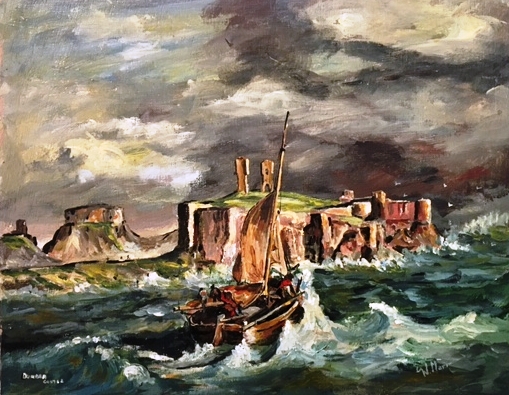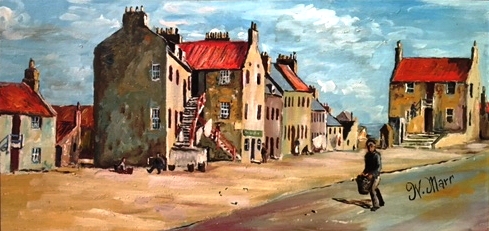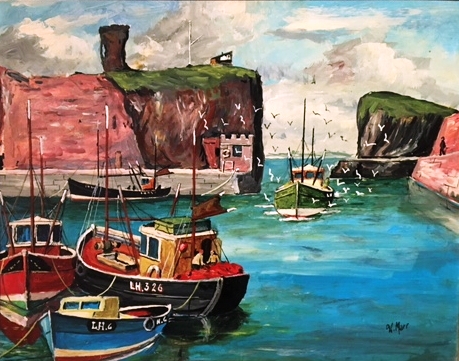To complete this year’s Resources pages, we will look at some paintings by local artist Willie “Topsy” Marr. His paintings were completed in the 1950s, 1960s and 1970s and were often done on the back of plyboard. This Topsy Marr – there have been a number of people with this name over the years, and not all related – lived in Pine Street, at the bottom of Cedar Street, and was a local plasterer. As part of the History Society’s Coast and Waters project, we had planned to display some of Topsy Marr’s pictures in the Town House, but this has not been possible, so they are being shared with you here. Willie Marr was a prolific painter and was self-taught. His many views of the harbour and castle area, also portraits, were produced mostly for charity. He donated some paintings to the then Sunshine Club which later became Dunbar Day Centre. The paintings were photographed by Fiona Smeed, who also contributed some of the text.
Above is the first painting, depicting an earlier view of the castle, pre-1868, when the archway with the Armorial Panel of the Dunbar Earls collapsed into the gunholes after a storm. According to this website, (good photos) “The central panel was carved with the arms of Dunbar over a shield containing a Lion Rampant. The shield to the left of this panel contained the three-legged arms of the Isle of Man while the shield to the right contained the arms of the lordship of Annandale. These are thought to date to the time of George, 10th Earl of March and Dunbar, who was a cousin of Black Agnes’ husband, Patrick. Thomas Randolph, the 10th Earl’s grandfather, was made Lord of Man and Lord of Annandale”. In the painting, the stormy sea is below an equally stormy sky and the artist has captured the motion of the sailing ship very well.
The next painting is one of Cat’s Row This is a well known historical view, photographed and painted by many, looking down towards the Cats’ Row which was demolished in 1933, with the Castlegate on the left, and the Rock House on the right. Note the well, where a figure of a lady can be seen, perhaps collecting water. The well can still be seen today, opposite the Volunteer Arms. You can see prints of Cat’s Row on the John Gray Centre website here and here ,and a coloured postcard here. In 1935, Cat’s Row was replaced with 12-30 (even Nos) Victoria Street and described here as “Kininimonth and Spence, 1935. Group of 10, symmetrical, paired, terraced 2-storey council houses, stepping down towards harbour”. The painting has vivid colours in the red roofs and the sky and there is some action in the painting. This is an idealised portrayal of Cat’s Row as the prints cited above show extreme poverty in that area,.
This is a typical Topsy Marr painting showing local boats in the harbour, with the castle and Coastguard Station on the top of the castle to the right. The Station was demolished in the mid- 20thcentury. The Harbour Master’s office, originally built as a tidal gauge, one of only three in Britain, is clearly seen. There is an interesting YouTube video on the tidal gauge here. This is a very pleasant view of the harbour, with the fishing boat coming in surrounded by seagulls. The artist’s use of a range of colours here adds to the quality of the painting.
The final painting by Willie Marr is a portrait of Bob Easingwood who was our chair Gordon Easingwood’s father. Despite his sight starting to fail, the artist completed this striking portrait from a newspaper article containing a black and white photograph of Bob Easingwood. The article appeared in the Edinburgh Evening News as part of a series entitled The Face of Scotland and Bob Easingwood was photographed to represent a typical Dunbar fisherman. The setting is a stormy one and Willie Marr was perhaps trying to capture the determination that fishermen needed when out in such conditions in this portrait.




You must be logged in to post a comment.